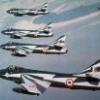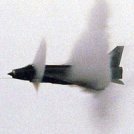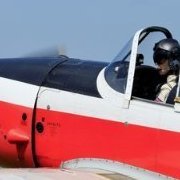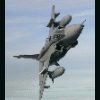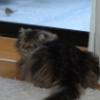-
Posts
695 -
Joined
-
Last visited
Profile Information
-
Gender
Male
-
Location
Shropshire
Recent Profile Visitors
4,298 profile views
NG899's Achievements

Obsessed Member (4/9)
451
Reputation
-
Thanks Troy. Searching for BP389 on here last night turned up zero results, glad to have your encyclopaedic knowledge to rely on. All the best Nick
-
NG899 started following Replacement Sea Harrier canopy windshield , Hawker Hurricane Question , 1:72 Special Hobby Sea Harrier FA.2 and 2 others
-
Something else which is odd, the aerial masts on the nearest two look to be offset to port from the fuselage spine, that or both of them have a patch under the aerial mast which could be related to some work on the radios/masts? Thoughts? There's no chance that 389 was originally painted DG/OG/MSG is there and for some reason the decision was made not to paint over the exhaust stain due to the amount of residue it contained. (I know, I'm really pushing the thought limits of the box's envelope with that one!) Hopefully @Troy Smith will come along with all the answers 🤞 Cheers Nick
-
Thanks Selwyn! A link to the instruction sheet pdf: https://www.pdf-archive.com/2020/04/19/airfix-72-raf-nato-weapons-set-05041/airfix-72-raf-nato-weapons-set-05041.pdf Which is a useful crib sheet, I've now got a cunning plan... Cheers Nick
-
@Selwyn One for your memory banks... "The live rounds were overall matt EDSG with a 2"Golden Yellow And 1" wide Black band over the top half (only) of the warhead section (top of conduit to top of conduit)". Please can you clarify if the black band was in front of or behind the yellow one? Many thanks Nick P.S. From speaking with several ex-Bucc and ex-Phantom pilots who flew SHARs during the Falklands War, they operated in sea conditions on many days when Buccs and Phantoms on Ark would have been deck-bound. All aircraft have their capability envelopes and limits!
-
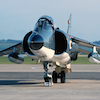
Spitfire FR.XVIII - Indian Air Force - Under-fuselage camera ports Q
NG899 replied to NG899's topic in Aircraft Cold War
Thanks Troy and Kari. -

1:72 Special Hobby Sea Harrier FA.2
NG899 replied to Navy Bird's topic in Work in Progress - Aircraft
GPS - thin white disc on a thin square mounting, with its corners rounded off slightly. Behind the cockpit serials were UHF aerials, a third carried under the port fuselage just ahead of the ventral fin. The GPS antenna replaced the starboard UHF aerial behind the cockpit which was relocated to the rear fuselage spine with the second GPS antenna behind it. Oil, upper and smaller, and fuel vents shown in the above photo near the starboard front nozzle. ZH809’s blue was roundel blue, confirmed by 899 maintainers back in the day. I never got a good answer for why they put the fuselage roundels where they did on it except that it was easier to pith them there than where they should have been to reflect the original markings of the FRS1. I think that answers the more recent posts. Cheers Nick -

1:72 Special Hobby Sea Harrier FA.2
NG899 replied to Navy Bird's topic in Work in Progress - Aircraft
GPS aerial discs, which meant that the Doppler panels below the nose could be removed hence why they don’t appear in photos of later FA2s. Hope that helps, Nick -

Spitfire FR.XVIII - Indian Air Force - Under-fuselage camera ports Q
NG899 replied to NG899's topic in Aircraft Cold War
Thanks guys. Now if only there was a good photo to hand…? 🤔 Cheers Nick -
I've a simple question for all the late-mark Spitfire gurus out there: When the downward pointing cameras were not installed were the ports sealed off with a glazing or cap of some kind? I'm building a 1/48 IAF FR.XVIII and know the aircraft I'm modelling HS654/NG didn't have the oblique cameras fitted, though I've kept the frame in situ. Having installed the under-fuselage ports, I'm now wondering whether/how to cap them before assembling the wings and fuselage. Many thanks for your help with this and, in return, should you ever need any Harrier help, please shout. All the very best Nick
-
Thanks Bob, the SHARs pylon adapter can be seen in the above photos of FA.2s, put simply, it’s the pointy thing directly above the missile. A similar adapter was used for WE.177A on the FRS.1. Cheers Nick
-
Thanks for that; I've amended the above post as your comments got me to look again at this photo of ZD615/723... I now think it also has one Sea Eagle and one 190-gal tank; probably overall EDSG or DSG. A second Sea Eagle's fins would be visible below the fuselage. (I did think for a while it may be a 100-gal tank to port, but amount of the LAU-7A rail the tank hides and the length of the Sea Eagle, the tip of which when fitted was closer to where the tip of a 190 is, means this is most likely a 190DT.) Cheers Nick (Who's finally joined Flickr this morning to enable me to upload photos here!)
-
Hello Selwyn, Bob, et al, Many thanks for your additions above. This is one of only three photos I know of showing a Sea Harrier loaded with a live Sea Eagle, FA.2 ZD608/717 of the FA.2 OEU in c.1994-5 when they were undertaking trials as part of the FA.2s operational release to service. ZD608 has what looks to be an early 190-gal tank in Extra Dk Sea Grey and white to port and a single AIM-9 ACQN pod on the port outboard. The light undersides of the tank could be reflection off the concrete and it's more likely the tank is overall EDSG. I believe it's a 190 rather than a 100-gal tank due to the amount of the LAU-7A rail on the port outboard pylon it hides, and based on discussions with an ex-CO of 899 NAS. At the time FA.2s still had the Doppler panels fitted and no GPS discs fitted; they were a few years away from respectively being removed and added. (The aircraft being part of the OEU would account for the lack of 899 NAS winged fists, the FA.2 OEU was a part of 899 hence the usual 899 side code range.) I presume the dayglo red was for photographic reasons after the trial drops. There look to be two black and white quartered discs on the rear of the missile, one on the side of the intake (overall EDSG or black?) and one below the conduit ahead of the rear fin. FA.2 ZD615/723 (seen behind) carried one Sea Eagle, also with a 190-gal tank and a single ACQN pod to port, but had the gun pods replaced with strakes and it had an empty centreline pylon. ZD608 looks to have an empty centreline pylon fitted too from close examination of the photo. All corrections gratefully received! Cheers Nick
-
For the curious, the text of my reply to Paul... A very interesting question and one that’s hard to answer 100%. Finding photos of either type carrying anything but test or drill rounds is almost impossible. Where you see them at an air show’s static park, I’d always take it with a pinch of salt as to whether that was an operational load. This is my best shot... FRS.1 - It was envisaged that Sea Eagle would be carried in pairs (on the inboard pylons) giving the FRS.1 a range of c.280nm radius from the carrier; the Sea Eagle has a range of c.70nm. Whether 9Ls were carried as well would depend on the threat expected from an enemy air arm and fuel capacity! Examples used in trials... XZ438/38 in testing, during 1982-3, Sae Eagle was carried on both inboards with either outer pylons removed or AIM-9L test rounds carried. XZ440/40 in trials, 1983-4, carried a camera pod on the centre line - modified from the GR.1/3 recce pod and a 190-gal tank on the starboard side. This would make sense if it was being used for anti-shipping strikes - the FRS1 had limited range and, if you’re going to use Sea Eagle, you want to be attacking ships well beyond the range of any shipboard ASMs being carried by the fleet. XZ450/50 was used in the 1982 trails and was sadly lost at Goose Green - with the Argentines finding the Sea Eagle controls there, their inclusion had meant that the rear RWR connections were removed which probably led directly to it being shot down with the loss of Lt Nick Taylor. XZ497/4 was flown by Mike Snelling (BAe test pilot) with twin LAU-7A rails outboard and test rounds in July 1982; this was also testing the twin LAU-7A rails developed based on the lessons of the Falklands War to carry more AAMs. Whether this would have been a war-time load out remains conjectural, considering the SHARs limited range already mentioned. Had it been fitted with an AAR probe too and there been a Fleet tanker operational…? FA.2 - While focusing on air-defence and ground attack, the FA.2 was cleared for Sea Eagle and the controls remained in its cockpit after the missile was withdrawn as a cost-saving measure. The only operational photos I have are of two 899 jets - ZD615/723 and ZD608/717 in 1994 during flying (dropping?) trials, both carrying two Sea Eagles on the inboard pylons. ZD615 had strakes fitted, empty centre-line and starboard outboard pylons and an AIM-9 Acquisition round on the port outboard pylon. ZD608 had gun pods fitted and the same starboard side configuration with, presumably, the same port side load out as ZD615. Both jets carried air-to-air refuelling probes and I’d work on this being the standard FA.2 configuration. Both FA.2s are in the overall Medium Sea Grey scheme with Doppler panels under the nose and no GPS aerials; white side codes and Royal Navy titles on the fins which are without 899's winged fist insignia. The Sea Eagleslook to have MSG bodies to the front fins then Dark Sea Grey bodies rearwards to the tailcone which, with the fins and conduits down the missiles' sides were daylgo red. The intake underneath and its jettison-able cover look to be DSG. These are probably test rounds, i.e. for carrying and dropping but not for use against a target. AFAIK, live rounds were overall grey; I’m seeking confirmation of this. Hope that helps Nick
-
Paul, drop me a PM with your email address in it and I’ll send you some things to help you. Cheers Nick
-
Binbrook87, Drop me a PM with your email and home address in it and I’ll send you a spare. Cheers Nick


